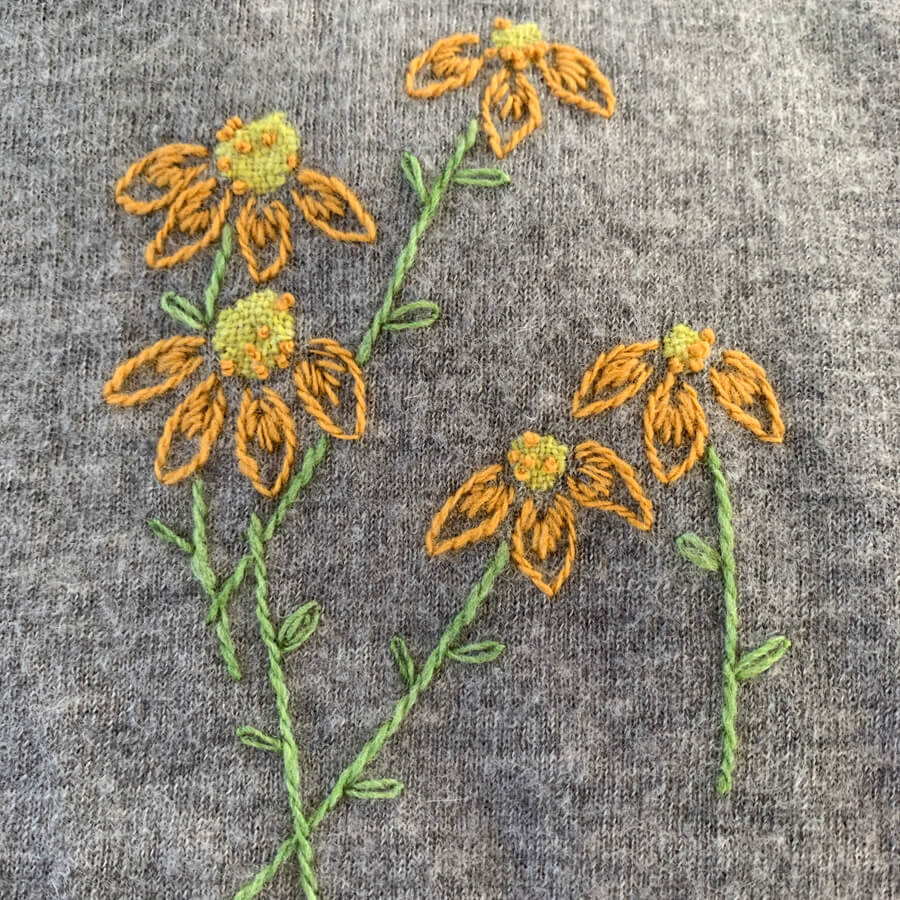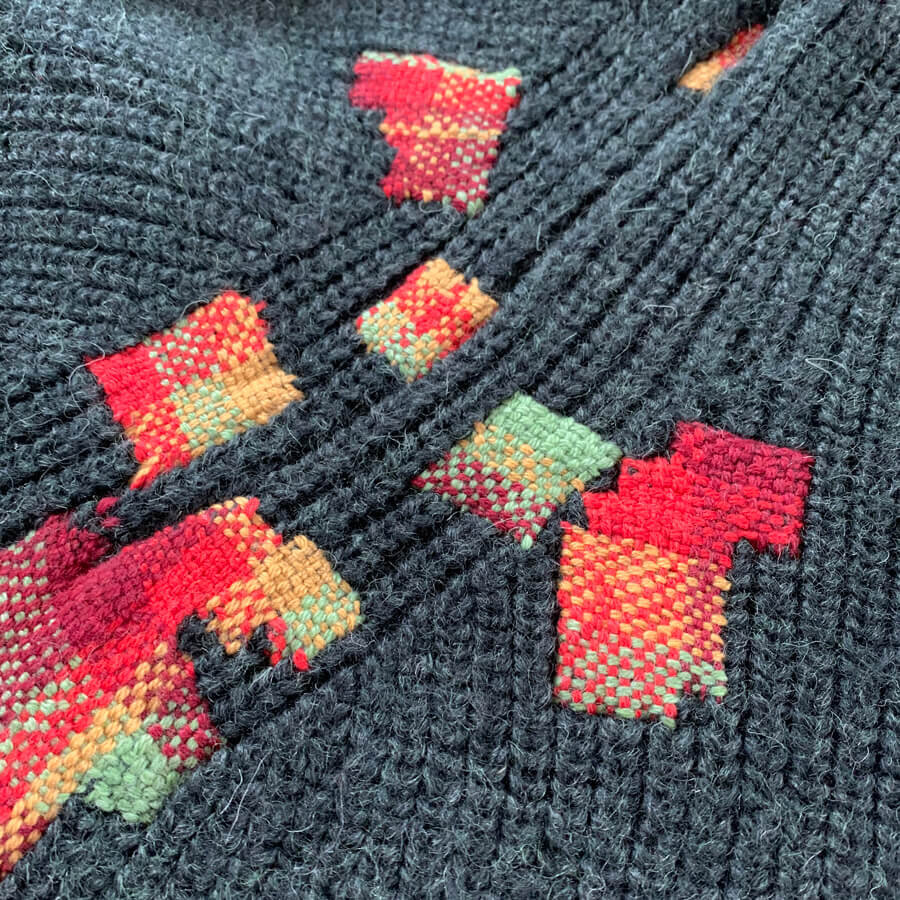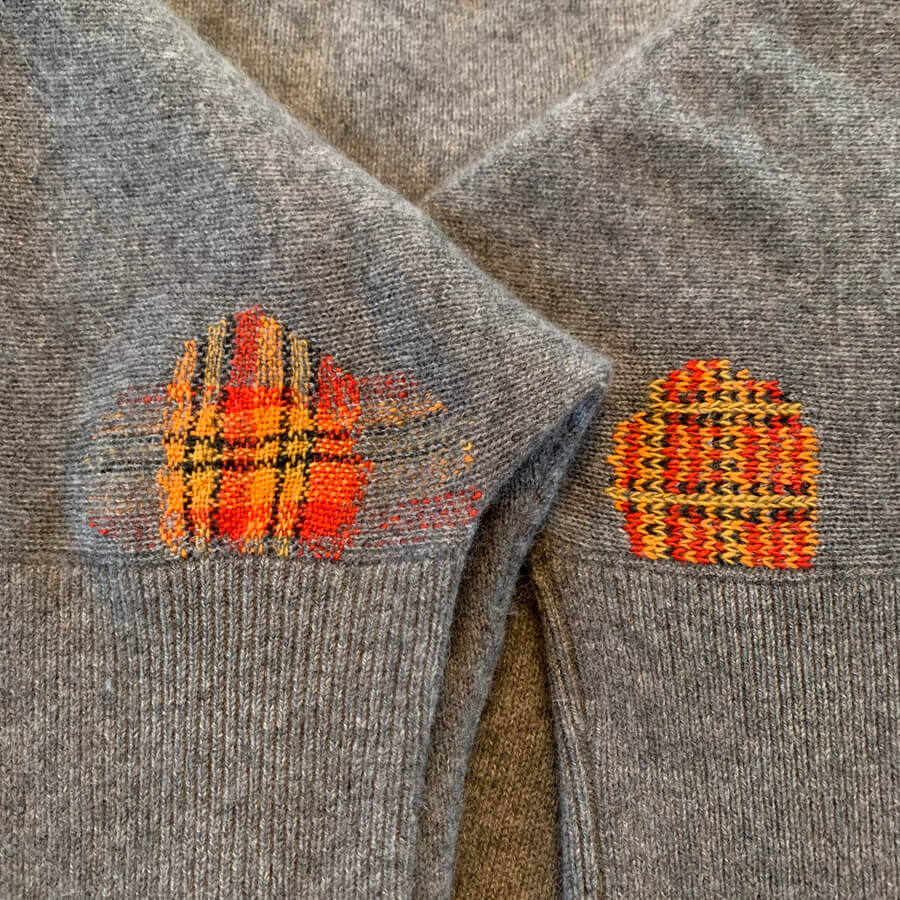Ask Me A Question on Mending!
Sometimes on my mending instagram account I ask if you have any questions about my work. This month I thought I would answer the questions here where it’s easier to give answers that are longer than a sentence!
How did you get started/ interested in mending? From who have you learnt mending? / How long have I been doing it?
I started mending about 3-4 years ago. As you can imagine, as a knitwear obsessive, I have a quite a lot of knitwear, and I can never bear to throw any of it out. So if something gets a moth hole, or chewed by the dog, and worn through, I keep it. Quite a few years ago I became aware of Celia Pym and Tom of Holland’s visible mending, and I loved it as alternative to invisible mending. I’ve always loved embroidery, so I started covering some of the tiny holes I had with embroidery. Then I taught myself how to darn, and I’ve developed my mending skills from there.
A recent mend on a cashmere top combining darning and embroidery.
I have been knitting, sewing, crocheting and embroidering since I was 6, and I studied textiles and knitwear at university, so these are not new skills for me, I’m really just using the skills I already have in a different way. When I started Collingwood-Norris, I wanted to create a business that wouldn’t have the same negative impact on the environment that so many fashion companies have. I put a lot of thought into how I could make my knitwear last for years, and part of that was offering a repair service. Running a small business hasn’t been what I expected, and it’s easy to get lost in what you’re working on, so it took me a few years before I launched my bespoke Visible Mending Service in 2019.
Do you do mends for people in Denmark?
I’m happy to mend knitwear from anywhere in the world, it will of course just take a bit longer and cost a bit more because of the postage. However, my repair service is currently suspended as I have a backlog to get through, so I’m not taking on anything right now. I have several elements to my business, and at busy times for knitwear it’s hard to get much mending done.
If you’d like to be informed when my mending service open again, you can sign up to my newsletter, and I’ll send out an email when the time comes!
Since Brexit, I have had so many issues sending orders to Denmark and Germany that I have had to stop sending things there. For commissions, we can arrange to send items with a courier, but that’s too expensive for everything else sadly.
Do you mend elbows on wool sweaters?
Yes! I love elbow repairs and I only work with natural fibres- mostly wool and cashmere. I recently realised elbows are what I most enjoy mending, I think because they’re generally a large enough area that I can be more creative with them. The larger ones offer a challenge in terms of tension, and I really enjoy that aspect too.
How to visibly mend a big hole on the elbow?
Take your time and be patient! The most complicated thing is keeping the tension, and that’s something that comes with practice I think. I often darn elbows, but sometimes I use Swiss darning instead- it really depends on which technique I think will be most effective and straightforward to do.
What do you use to mend with?
I always use the most appropriate yarn I can find for the garment I’m mending. So if it’s wool I use wool, for cashmere I use cashmere or sometimes wool as I don’t have a great selection of colours in cashmere and wool will perform the same in the wash.
I have a selection of the wool I use available if you’re looking for something for your own projects.
What does the back of a visible mend look like?
I generally don’t photos of the back of my work, as the purpose of my photos is to have a record of my designs rather than anything else. All of my visible mending how-to guides show how I sew in my ends if you’d like to learn how to secure your ends neatly.
Below is an example of the front and back or one of my knitwear repairs.
How do you get the edges to look so neat? How do you make your darning so tidy?
Practice! Everything in mending is about practice.
If you’d like to learn how to repair cuffs and edges and get them neat, then I have a guide for that…
Do you use a darning mushroom?
Only if I’m working on a sock heel, and then I find them quite useful for keeping the shape. Otherwise I don’t use anything other than a needle for darning- I enjoy the hand process and I don’t have a need for any gadgets or aids. I do think darning mushrooms are beautiful objects though, so I own quite a lot of them!!
How long does a repair like this take to do?
This question was asked about the image below, and I think it took roughly about an hour. None of the mends I do are quick fixes, this is time consuming work that has to be done with care, and often my mending takes many hours is not days for garments with larger areas of damage. I also think of each mends as a mini design project, and the design element adds to the time pieces take, as some though has to go into each one.
Have you even done woven mending on non-woven fabric?
I almost always mend on fabrics that aren’t woven I specialise in knitted fabrics. Most of the mends you see here or on my Instagram are woven mends on knits. I find that darning is a very versatile skill that be used on any fabric.
I have tried some other visible mending techniques on woven fabrics, and you can take a look at an example of that in my blog ‘visibly mending a linen shirt’.
I know you work more in wool and yarn, but are t-shirt arm pits mendable?
Do you approach repairs like pants, particularly in the seat, differently than other things?
I’ve chosen to answer these two questions together, as neither are particularly my area of expertise! Yes you can mend T-shirts, and you could darn them or patch them. If darning, then I think you would probably need to use one strand of embroidery thread. If patching, I would choose a similar weight jersey fabric- maybe from another old t-shirt you don’t want to save, or you could probably even use a piece of a cotton sock that’s worn through.
Working on denim or any kind of fabric used for trousers is very different from knitwear, so I do approach it differently, although I don’t do a lot of it. I have darned my jeans before, and it does work, but I’ve also patched them and I think patching may be the better and stronger approach. Look up Sashiko or get your sewing machine out for patches!
If you’d like to start learning how to visibly mend your own knitwear, my “ Introduction to Darning” workshop is a great place to start. It covers different approaches to darning, how to combine them, as well as a couple of patterns, and it can come with materials to get you started. These are skills that will serve you well over the years and save many sweaters!










